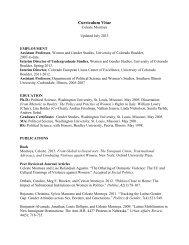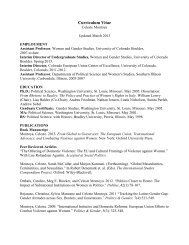Are you a man?: Performing Naked Protest in India - Women and ...
Are you a man?: Performing Naked Protest in India - Women and ...
Are you a man?: Performing Naked Protest in India - Women and ...
You also want an ePaper? Increase the reach of your titles
YUMPU automatically turns print PDFs into web optimized ePapers that Google loves.
620 ❙ Misri<br />
alternately <strong>in</strong>vok<strong>in</strong>g both good <strong>and</strong> bad mascul<strong>in</strong>ities, Chauhan’s lament<br />
re<strong>in</strong>forced an idealized mascul<strong>in</strong>ity by mark<strong>in</strong>g its absence <strong>and</strong> reveal<strong>in</strong>g<br />
<strong>in</strong> its stead a failed (bad) mascul<strong>in</strong>ity, which <strong>in</strong> the relational logic of gender<br />
is no mascul<strong>in</strong>ity at all. In effect her naked body functioned not as a<br />
challenge to mascul<strong>in</strong>ity but as a signifier of its proper role.<br />
The Meitei women’s protest signified the relation between violence<br />
<strong>and</strong> women’s bodies somewhat differently, resist<strong>in</strong>g such <strong>in</strong>vocations of<br />
chivalrous mascul<strong>in</strong>ity <strong>and</strong> <strong>in</strong>stead foreground<strong>in</strong>g violence at the <strong>in</strong>tersections<br />
of gender <strong>and</strong> citizenship. Evident <strong>in</strong> Chauhan’s protest was a<br />
conflation between gender identities <strong>and</strong> gendered modes of power that<br />
is commonplace when gender is taken as a reference po<strong>in</strong>t for protest. As<br />
Brown po<strong>in</strong>ts out, “while gender identities may be diverse, fluid <strong>and</strong> ultimately<br />
impossible to generalize, particular modes of gender power may<br />
be named <strong>and</strong> traced with some precision at a relatively general level”<br />
(1995, 166). What we underst<strong>and</strong> as mascul<strong>in</strong>ist (violence, for <strong>in</strong>stance)<br />
is not reducible to the behavioral propensities of men. Likewise, genderor<br />
caste-specific violence <strong>and</strong> vulnerability must be understood as functions<br />
not of the relative attributes of men <strong>and</strong> women, upper <strong>and</strong> lower caste,<br />
but of mechanisms of dom<strong>in</strong>ation through which women as well as men<br />
may be subjected to gendered violence by male or nonmale actors across<br />
the spectrum of race <strong>and</strong> caste.<br />
Rather than stag<strong>in</strong>g women’s bodies as the grounds of essential fem<strong>in</strong><strong>in</strong>e<br />
vulnerability, the Meitei women’s protest staged women’s bodies as<br />
sites of violence <strong>and</strong> their vulnerability to custodial rape as the historical,<br />
legitimated, <strong>and</strong> legislative product of a state <strong>in</strong> which gendered <strong>and</strong> castebased<br />
(as exemplified by Mahasweta’s Draupadi) modes of power converged<br />
<strong>in</strong> the Armed Forces Special Powers Act. While the women’s position<strong>in</strong>g<br />
of themselves as Manorama’s mothers certa<strong>in</strong>ly established a<br />
fem<strong>in</strong><strong>in</strong>e relationship of care, protection, <strong>and</strong> nurturance, the maternal<br />
here also symbolizes the bonds of political solidarity with the dead wo<strong>man</strong><br />
rather than a natural care-giv<strong>in</strong>g fem<strong>in</strong><strong>in</strong>ity. It possibly also represented a<br />
claim to respectability that may have provided the women with a strategic<br />
legitimacy.<br />
Furthermore, the Meitei women’s protest reta<strong>in</strong>s the protestors’ viability<br />
as political actors rather than exhort<strong>in</strong>g men of the state to relieve<br />
them from the burden of action. Unlike Chauhan’s perfor<strong>man</strong>ce, the<br />
Meitei women’s protest refra<strong>in</strong>ed from appeal<strong>in</strong>g to a notion of chivalrous<br />
mascul<strong>in</strong>ity, focus<strong>in</strong>g its ire <strong>in</strong>stead on the violent triumph of mascul<strong>in</strong>ity<br />
<strong>in</strong> its dom<strong>in</strong>ative aspect. As <strong>in</strong> Mahasweta’s “Draupadi,” the willful nakedness<br />
of the protestors mimes, but also <strong>in</strong>verts, the enforced nakedness






